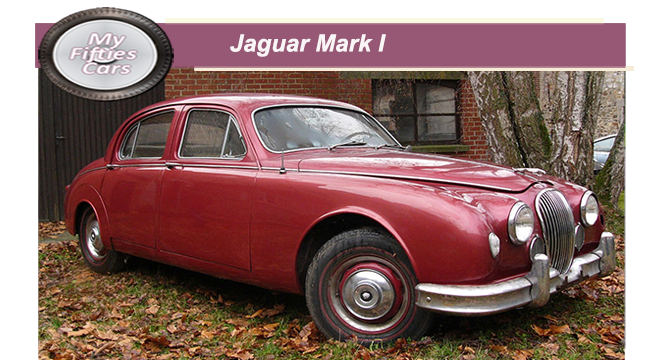
The release of the Jaguar Mark 1 series in 1955, was one of the most significant events in the company's history is that the 2.4 litres engined version was not only its first-ever monocoque production car to come out of their Coventry plant but also the first to use a short-stroke version of the XK engine.
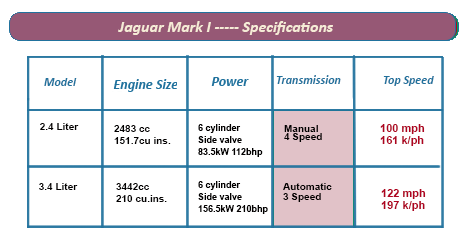 The Jaguar Mark 1’s shell was developed in close cooperation with the Pressed Steel Company (who not only built the shells but also engineered the structure).
The Jaguar Mark 1’s shell was developed in close cooperation with the Pressed Steel Company (who not only built the shells but also engineered the structure).
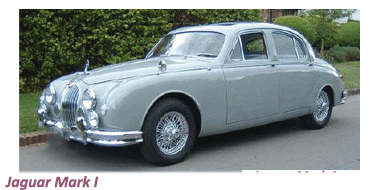 The results met with the approval of the motoring public at large as this was the first "small" new Jaguar of the post-war period.
The results met with the approval of the motoring public at large as this was the first "small" new Jaguar of the post-war period.
 Weighing in at a substantial 900lb (around 400 kilos), the Mark I was still regarded as being a tad overweight, although certainly less than its contemporary, the massive Mk VIIM.
Weighing in at a substantial 900lb (around 400 kilos), the Mark I was still regarded as being a tad overweight, although certainly less than its contemporary, the massive Mk VIIM.
Built around a 107.4in. Wheelbase, the Jaguar Mark 1 series four-door saloon was fitted with a 112bhp 2483cc version of the XK engine which was 501b lighter than the 3.4-litre unit.
The XK engine came backed up by two downdraught Solex carburettors,fitted in place of the SUs fitted on the 3.4's.
As was the case with the more substantial Jaguars of the day, a Moss gearbox was standard, and while a Laycock overdrive was optional.
![]()
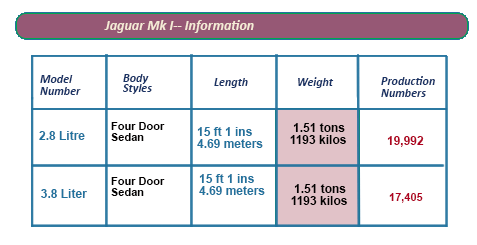 Because disc brakes were still in their infancy, Jaguar opted to fit servo-assisted drum brakes on the Mk1s.
Because disc brakes were still in their infancy, Jaguar opted to fit servo-assisted drum brakes on the Mk1s.
T he Jaguar Mark 1 2.8’s front suspension, by coil springs and wishbones, with Burman worm-and-nut steering, was a real innovation, as was rear suspension using cantilever leaf springs, radius arms and a short Panhard rod.
he Jaguar Mark 1 2.8’s front suspension, by coil springs and wishbones, with Burman worm-and-nut steering, was a real innovation, as was rear suspension using cantilever leaf springs, radius arms and a short Panhard rod.
 For styling, rather than any other reason, the rear track was 4.5in narrower than the front end, while even narrower than that of the Morris Minor!
For styling, rather than any other reason, the rear track was 4.5in narrower than the front end, while even narrower than that of the Morris Minor!
While not as lavishly equipped as some of its counterparts in the Jaguar range, the 2.4 did come with an impressive wooden facade dashboard and leather seats.
![]()
The Mark 1 3.4 was capable of reaching the top speed of 120mph (around 200 kph).
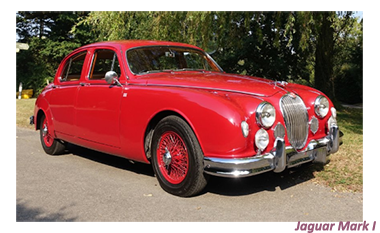 The basic finish of the Mark 1 series was part of a message from Jaguar that the model had been developed to fill a spot as an entry-level saloon, offering excellent value for money.
The basic finish of the Mark 1 series was part of a message from Jaguar that the model had been developed to fill a spot as an entry-level saloon, offering excellent value for money.
>Bargain or not, the 2.4 was so obviously underpowered, causing Jaguar to respond with the release of a 3.4-liter engined version of the Mark 1 saloon, a release that was welcomed with open arms when it appeared in March of 1957.
 As far as the external finish , the updated version came with a slightly wider grille, impressive cutaway rear spats and even more wire wheels, obviously designed to send a message that although entry-level cars were filled a gap in the market, the public still expected a lot more power from their Jaguar.
As far as the external finish , the updated version came with a slightly wider grille, impressive cutaway rear spats and even more wire wheels, obviously designed to send a message that although entry-level cars were filled a gap in the market, the public still expected a lot more power from their Jaguar.
The Jaguar Mark 1 Series was discontinued in 1959, to be replaced by the Mark 2. During the four years that it was in production, Jaguar sold around 38,000 of these cars, among them, interestingly enough, slightly more 2.4 engined versions than the 3.4 versions.


